Words by Emma Langman
Take inspiration from our need-to-know guide on the historical significance of your pretty petals
Beautiful bouquets
It’s commonplace that weddings feature flowers to decorate and dazzle the guests: from tall table arrangements and scattered petals to dress up your reception space, through to buttonholes and the must-have bridal bouquet. We take it for granted, but where did this tradition come from?
Unfortunately, the answer isn’t as romantic as we had hoped, as Edinburgh-based florist Tattie Graham of Tattie Rose Flowers explains: “The tradition of carrying a bouquet of flowers down the aisle started in the Middle Ages when baths were few and far between. The bouquet would have been scented to mask the fact that the bride probably hadn’t bathed for a month! It soon became a tradition that stuck. I think it also gives your hands something to do on possibly the most nerve-racking short walk of your life.”
While modern brides will surely make it to the shower on the day of the wedding, the custom has continued due to the classic beauty that flowers bring to your celebration. “Today, brides choose to carry flowers to follow tradition, but also to add beauty and elegance to their wedding, and to enhance the overall theme,” advises Karen Barnes, Head of Floral Gifting at Interflora.
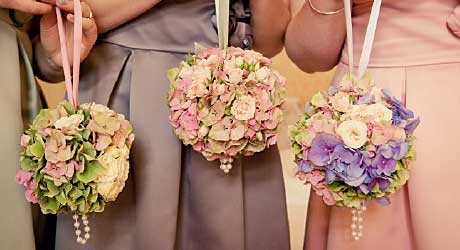
Symbols of love
Alongside the bridal bouquet, there are bridesmaids’ posies, buttonholes and, larger floral decoration arrangements to consider. From wreaths and pew ends to decorate your church or ceremony venue, to glass table designs or posies wildly placed in vintage teapots, there’s a whole host of ways that you can utilise flowers to enhance the look of your celebration. But to start with, you need to decide which flowers you want to include.
Most couples will opt for those blooms they like the look of and, while we agree that this is an important box to tick, it’s worth considering the symbolism behind your flowers to bring an added layer of meaning to your day.
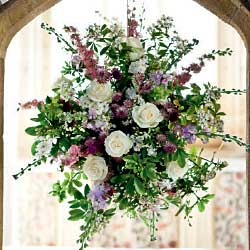

Global traditions
Different cultures and countries around the world employ flowers for unusual customs, and these can bring a nice touch to your day, especially if you have a family tie linking you to them. “I lived in India for a while where flowers are very important in everyday life, but even more so at weddings. The marigold features strongly in all wedding ceremonies, adorning every part of it from the decorations to garlands around the horses necks, as it’s believed to be sacred and bring good luck from the gods,” says Tattie Graham.
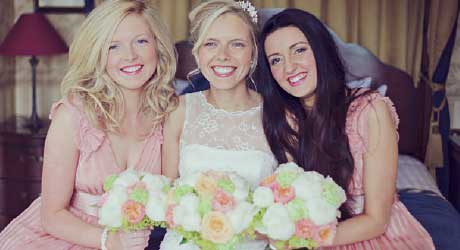

Advice Time
It can be difficult to decide on the look of your floral arrangements no matter what blooms you’ve chosen. Take inspiration from other people’s weddings by looking online and in magazines. Florists’ websites that often display a gallery of past designs too. Most importantly, talk to your florist – they’re the experts in creating original designs that will complement your setting and are well-placed to come up with your dream look.
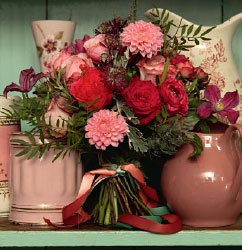

Vic Brotherson of florist Scarlet and Violet has created stunning floral designs for many celebrity clients, (including Kate Moss’s wedding to Jamie Hince last summer). She advises, “It is my job to make sure that any venue looks as beautiful as possible for a wedding, whether with huge vases and garlands or hanging balls of flowers and foliage. Flowers should complement the surroundings and look like they belong there. Look carefully at the crucial spaces and blow the budget there rather than spending on flowers in every area.”
[hr]
Symbols of love
The meaning of flowers dates back to the Victorian era when the ‘language of flowers’ was created as a romantic way for lovers to express themselves without the need for words. If you want to inject symbolism into your wedding flowers, read Interflora’s guide to the most popular wedding flowers and the meanings they are said to hold…
• Roses
Roses symbolise ‘love and beauty’ so it is hardly surprising that they are one of the most popular flowers for wedding arrangements. Whether used for a simple, single buttonhole or as part of an elaborate bouquet, the rose is a deservedly popular choice for brides.
• Stephanotis
Meaning ‘marital happiness’, the stephanotis flower is a traditional choice for brides. These little trumpet-shaped flowers look delightful worked into formal shower bouquets. Their scent is a lovely accompaniment to the bride as she walks up the aisle.
• Calla lilies
These elegant flowers signify ‘magnificent beauty’ and may just be the wedding flower of the moment. Extremely fashionable for bridal bouquets, buttonholes and bouquets for the bridesmaids, the calla lily adds an element of sophistication.
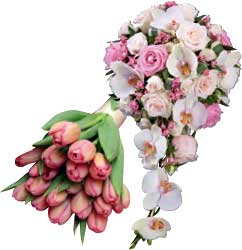

• Hydrangea
The big showy head of the hydrangea flower is perfect for weddings, adding a touch of vintage chic to bouquets and larger arrangements. Meaning ‘understanding’, the hydrangea is a good choice for couples embarking on their new chapter together.
• Freesias
Meaning ‘innocence and trust’, freesias are a popular bridal bloom. This very versatile type of flower is now available all year round, in a spectrum of colours to suit all wedding schemes.
• Lily of the Valley
The delicate, bell-shaped flowers of Lily of the Valley signify ‘happiness’ and are considered one of the most traditional types of wedding flower. Favoured by royal brides, including the Duchess of Cambridge, Lily of the Valley has a timeless elegance that is just perfect for weddings.








